
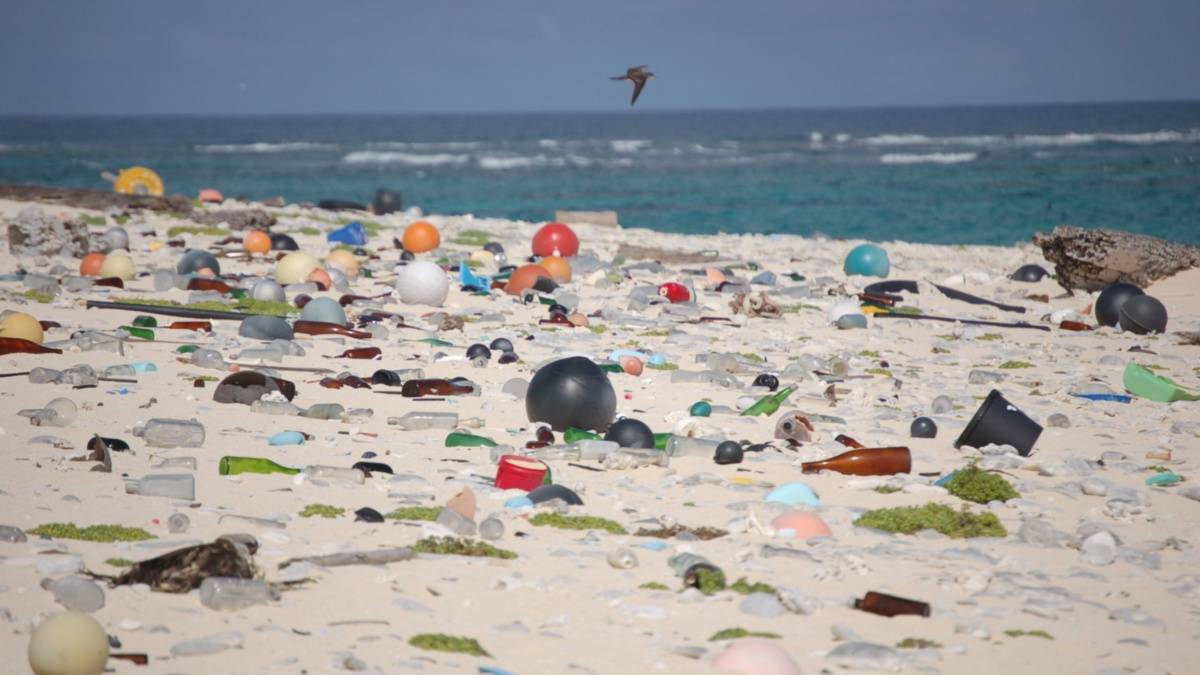
New research shows that there's actually a larger quantity of plastic in the ocean than previously thought. Susan White / USFWS / Flickr / CC by 2.0
By Elizabeth Claire Alberts
In 1997, Charles Moore was sailing a catamaran from Hawaii to California when he and his crew got stuck in windless waters in the North Pacific Ocean. As they motored along, searching for a breeze to fill their sails, Moore noticed that the ocean was speckled with “odd bits and flakes,” as he describes it in his book, Plastic Ocean. It was plastic: drinking bottles, fishing nets, and countless pieces of broken-down objects.
“It wasn’t an eureka moment … I didn’t come across a mountain of trash,” Moore told Mongabay. “But there was this feeling of unease that this material had got [as] far from human civilization as it possibly could.”
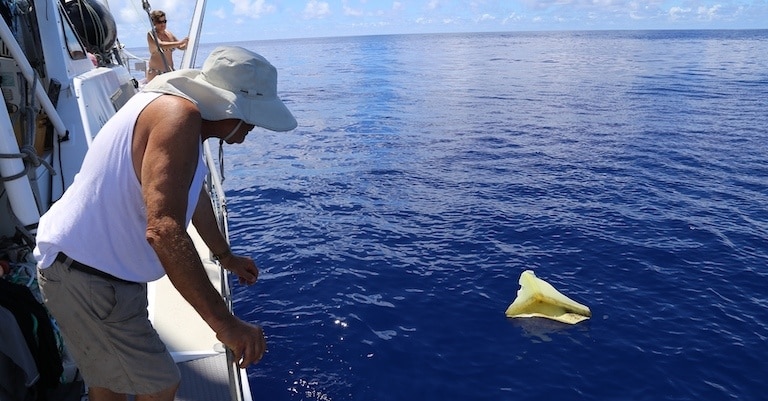
Captain Charles Moore looking at a piece of floating plastic in the ocean. Algalita Marine Research and Education
Moore, credited as the person who discovered what’s now known as the Great Pacific Garbage Patch, returned to the same spot two years later on a citizen science mission. When he and his crew collected water samples, they found that, along with larger “macroplastics,” the seawater was swirling with tiny plastic particles: microplastics, which are defined as anything smaller than 5 millimeters but bigger than 1 micron, which is 1/1000th of a millimeter. Microplastics can form when larger pieces of plastics break down into small particles, or when tiny, microscopic fibers detach from polyester clothing or synthetic fishing gear. Other microplastics are deliberately manufactured, such as the tiny plastic beads in exfoliating cleaners.
“That’s when we really had the eureka moment,” Moore said. “When we pulled in that first trawl, which was outside of what we thought was going to be the center [of the gyre], and found it was full of plastic. Then we realized, ‘Wow, this is a serious situation.'”
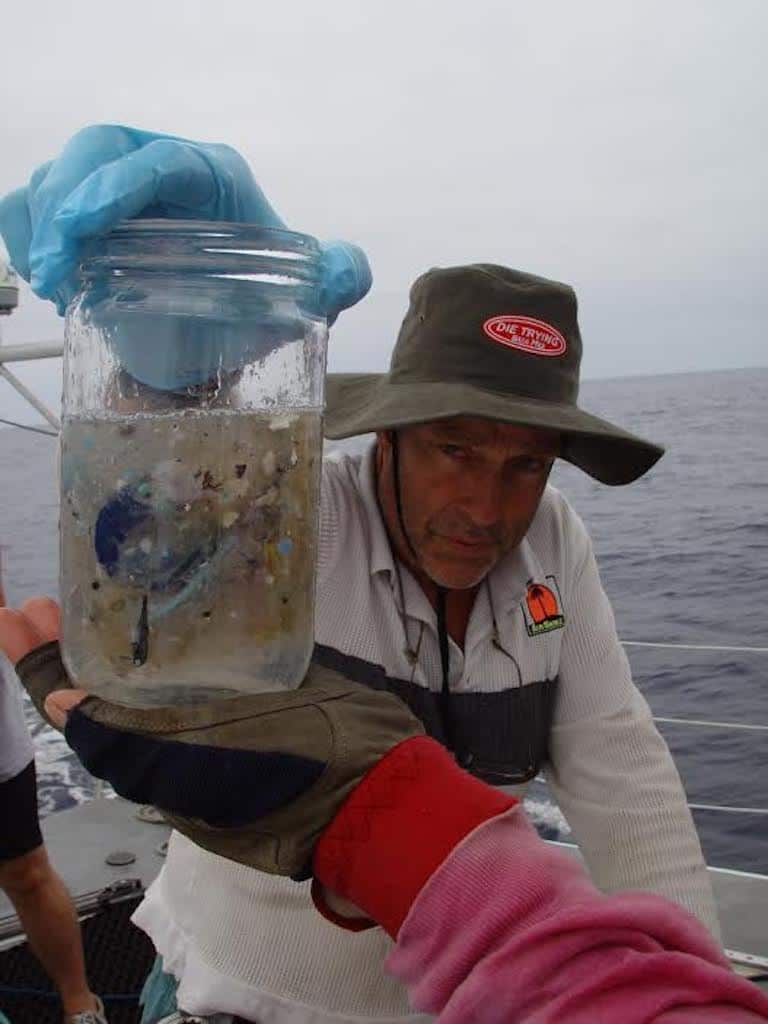
Captain Charles Moore holding up a jar of plastic-filled seawater from a research expedition in 2009. Algalita Marine Research and Education
Since Moore’s discovery of the plastic-swirling gyres, there’s been a growing amount of research to try and understand the scale of the plastic pollution issue, including several studies from 2020. This new research shows that there’s actually a larger quantity of plastic in the ocean than previously thought, and that the plastic even enters the atmosphere and blows back onto land with the sea breeze. Recent studies also indicate that plastic is infiltrating our bodies through food and drinking water. The upshot is that plastic is ubiquitous in the ocean, air, food supply, and even in our own bodies. The new picture that is emerging, scientists say, is of a biosphere permeated with plastic particles right down to the very tissues of humans and other living things, with consequences both known and unknown for the lifeforms on our planet.
How Much Is Really in the Ocean?
In the past 70 years, virgin plastic production has increased 200-fold, and has grown at a rate of 4% each year since 2000, according to a 2017 study in Science Advances. Only a small portion of plastics are recycled, and about a third of all plastic waste ends up in nature, another study suggests.
While new research indicates that plastic is leaking into every part of the natural world, the ocean has long been a focal point of the plastic pollution issue. But how much is actually in the sea?
Moore says it’s “virtually impossible” to get an accurate estimate because of the ongoing production of plastic, and the tendency for plastic to break down into microplastics.
“This count is constantly increasing, and it’s increasing at a very rapid rate,” he said. “It’s a moving target.”
One commonly cited study, for which Moore acted as a co-author, estimated that there are more than 5.25 trillion plastic pieces floating in the ocean, weighing more than 250,000 tons, based on water samples and visual surveys conducted on 24 expeditions in five subtropical gyres. But even at the time of publication in 2014, Moore said he knew “that was an underestimate.”
A more recent study published this year, led by researchers at Plymouth Marine Laboratory, indicates that there’s a lot more microplastic in the ocean than we previously thought. When taking samples from the ocean, most researchers use nets with a mesh size of 333 microns, which is small enough to catch microplastics, but big enough to avoid clogging. But the team from Plymouth Marine Laboratory used much finer 100-micron nets to sample the surface waters in the Gulf of Mexico and the English Channel.
“Our nets clogged too, so we used shorter trawls and a specialized technique for removing all the plankton — microscopic plants and biota — from the sample to reveal the microplastics,” Matthew Cole, a marine ecologist at Plymouth Marine Laboratory and author of the study, told Mongabay in an email. “This process is quite time-consuming, so it’d be challenging for all samples collected to be treated this way.”

The research team at Plymouth Marine Laboratory collecting water samples. Matthew Cole
The researchers found there were 2.5 to 10 times more microplastics in their samples compared to samples that used 333-micron nets.
“If this relationship held true throughout the global ocean, we can multiply existing global microplastic concentrations ascertained using 333-micron nets, to predict that globally there are 125 trillion plastics floating in the ocean,” Cole said. “However, we know these plastics keep on degrading, and these smaller plastics would be missed by our smaller 100 micron net — so the true number will be far greater.”
Another team of researchers delved down to the seafloor in the Tyrrhenian Sea in the Mediterranean to take sediment samples. They found that microplastic accumulated at depths of 600 to 900 meters (about 2,000 to 3,000 feet), and that certain spots in the ocean, termed “microplastic hotspots,” could hold up to 1.9 million pieces per square meter — the highest level ever to be recorded on the seafloor. The results of this study were published in Science in June 2020.
“We were shocked by the sheer number of [microplastics],” Ian Kane, the study’s lead author, told Mongabay in May. “1.9 million is enormous. Previous studies have documented much smaller numbers, and … just talked about plastic fragments, but it’s fibers that are really the more insidious of the microplastics. These are the things that are more readily consumed and absorbed into organisms’ flesh.”
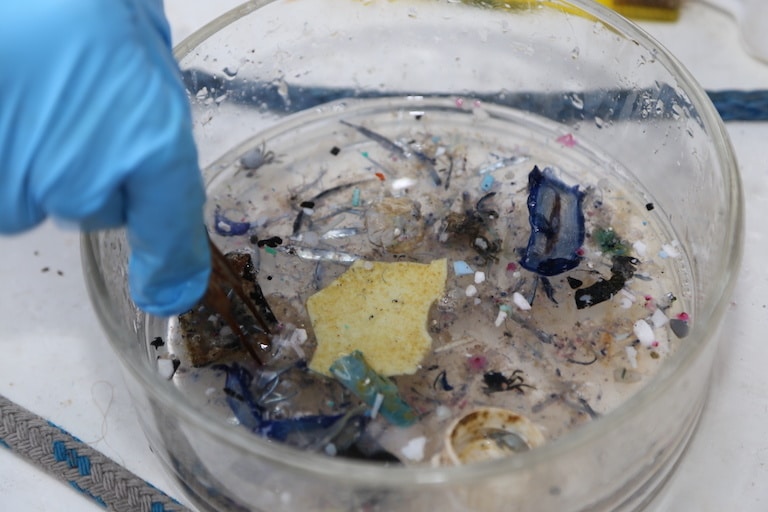
A water sample containing plastic. Algalita Marine Research and Education
While these studies shine light on the fact that there’s definitely more plastic in the ocean than we think, it still doesn’t complete the picture, says Steve Allen, a microplastic expert and doctoral candidate at the University of Strathclyde in the U.K. Large quantities of microplastics still appear to be “missing” from the ocean, he said. For instance, one study suggested that 99.8% of oceanic plastic sinks below the ocean surface layer, making it difficult to detect, but Allen says this doesn’t fully explain what’s happening to all of the plastic that enters the ocean.
“We’re finding some of it,” Allen told Mongabay. “But we’re … trying to explain where the rest of it went.”
Allen and his wife, fellow scientist Deonie Allen, also from the University of Strathclyde, have been working to find their answer, or at least part of it, in an unlikely place: up in the sky.
‘Microplastics Are in Our Air’
As the ocean churns and breaks waves, air is trapped in tiny bubbles. When those bubbles break at the sea’s surface, water rushes to fill the void, and this causes tiny, micro-sized particles, like flecks of sea salt or bacteria, to burst into the atmosphere. A new study, published in PLOS ONE, suggests that microplastics are entering the air in the same way.
“[Bubbles] act a little bit like velcro,” Deonie Allen told Mongabay. “Rather than the bubble going through the plastic soup and coming to the surface and not bringing any of the plastics with it, it actually collects [the plastic] and hangs on to it as it comes up. And when it bursts, the energy from the creation of the jet to fill the hole that’s left in the sea … is what gives it the force to eject the plastic up into the atmosphere.”
A lot of previous research on plastic pollution in the ocean has assumed that plastic remains in the seawater and sediment, or gets washed ashore. But this study takes a pioneering step to suggest that ocean plastic is entering the atmosphere through the sea breeze.
“This was just the next logical step to see whether what we’re putting into the ocean was actually going to stay there, or whether it would come back,” Steve Allen said.
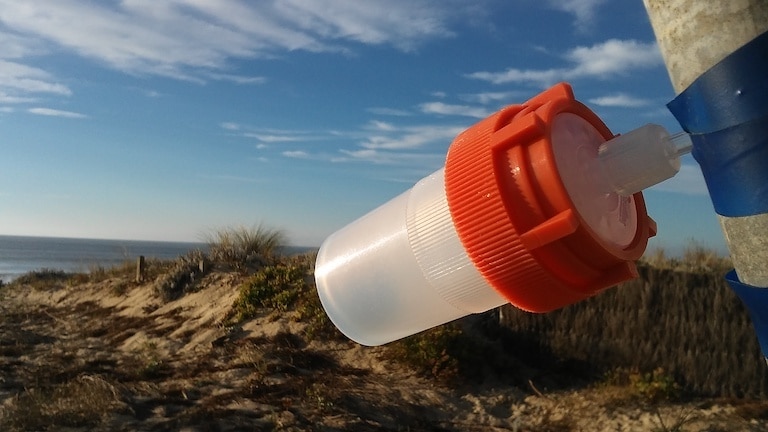
A device used to collect air and mist samples to test for microplastics. Steve Allen
To obtain the necessary data for this study, the research team collected air and sea spray samples on the French Atlantic coast, both onshore and offshore. They found that there was a high potential for ocean microplastics to be released into the air, and suggested that each year, 136,000 tons of microplastics were blowing ashore across the world, although Steve Allen said this number was “extremely conservative.”
This study specifically looked at microplastics, but the much smaller nanoplastics are likely going into air by the same means, according to the Allens. But detecting nanoplastics in the water or air can be challenging.
While this is the first study to look at the ocean as a source of atmospheric plastics, other research has examined the capacity of land-based plastics to leach into the air. One study, authored by the Allens and other researchers, found that microplastics were present in the air in the Pyrenees Mountains between France and Spain, even though the testing site was at least 90 kilometers (56 miles) from any land-based source of plastic, such as a landfill. This suggests that the wind can carry microplastics over long distances.
“We know that microplastics are in our air everywhere, from the looks of it,” Deonie Allen said.
More research needs to be done to understand the implications of atmospheric microplastics on human health, but according to the Allens, it can’t be good for us.
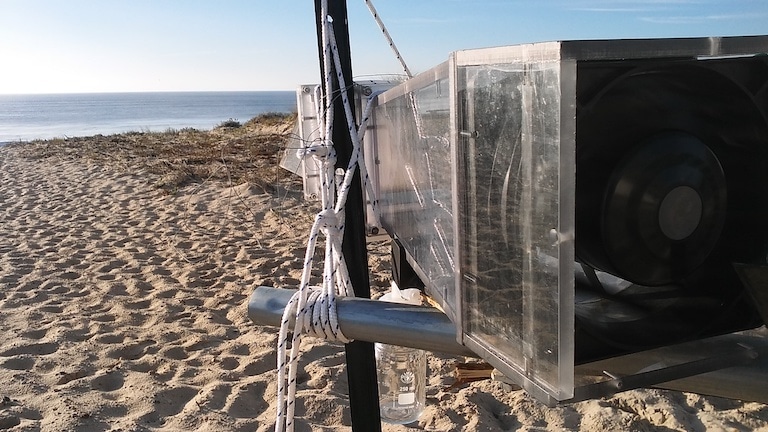
A “cloud catcher” used to collect data for research on microplastics in the atmosphere. Steve Allen
“Microplastics are really good at picking up the contaminants in the surrounding environment — phthalates, flame retardants, heavy metals,” Deonie Allen said. “That will get released into the body, relatively effectively.”
Enrique Ortiz, a Washington, D.C.-based ecologist and journalist who writes on the plastic pollution issue, says that this evidence should be a “wake up” call to humanity.
“The oceans are picking up the plastic that we throw in it, and that’s what we’re breathing,” Ortiz told Mongabay “And that’s the part that really … amazes me.”
“But it’s not just happening in coastal cities,” he added. “No matter where you go, [even] in the middle of the Arctic … the human imprint is already there.”
We’re not just inhaling microplastics through the air we breathe — we’re also getting it through the water we drink and the food we eat.
‘Our Life Is Plasticized’
Plastic waste isn’t just leaking into the ocean; it’s also polluting freshwater systems and even raining or snowing down from the sky after getting absorbed into the atmosphere, according to another study led by Steve and Deonie Allen. With microplastics being so ubiquitous, it should come as no surprise that they are also present in the food and water we drink.
Drinking water, including tap and bottled water, is the largest source of plastic in our diet, with the average person consuming about 1,769 tiny microplastic particles each week, according to a 2019 report supported by WWF. Other primary sources of microplastics include shellfish, beer and salt.
A new study published this year in Environmental Research found that microplastics were even present in common fruits and vegetables. Apples had one of the highest microplastic counts, with an average of 195,500 plastic particles per gram, while broccoli and carrots averaged more than 100,000 particles per gram.
“The possibility of plastics in our fruit and vegetables is extremely alarming,” John Hocevar, ocean campaign director for Greenpeace USA, said in a statement. “This should prompt additional studies to assess how much plastic we are consuming through our produce each day and examine how it is impacting our health.”
“Decades of plastic use have contaminated our air, water, and soil,” Hocevar added. “Eating just a bite of an apple could now mean eating hundreds of thousands of bits of plastic at the same time.”
Through normal water and food consumption, it’s estimated that the average person consumes about 5 grams of plastic each week, equivalent to the size of a credit card, according to the WWF report.
“Plastic is everywhere,” Thava Palanisami, a microplastics researcher at the University of Newcastle, Australia, and contributor to the WWF report, told Mongabay. “We live with plastic and our life is plasticized — that we know. But we don’t know what it does to human health. That’s the biggest question mark.”
While it’s not entirely clear how plastic affects human health, research suggests that the inhalation of fibrous microplastics can lead to respiratory tract inflammation. And another study, referenced in the WWF report, shows that fish and other marine animals with high concentrations of microplastics in their respiratory and digestive tracts have much higher mortality rates. Another study, published in 2020, indicates that plastic accumulates in the muscle tissue of fish.
“If you look at what happens, for example, in fish — it [plastic] stays in their muscles,” Ortiz said. “It’s scary. If you look at the numbers, you’re eating something in the order of one kilo of plastic every three years. I wonder, in our lifetime … if a percentage of our weight will be plastic that is still in our muscles.”
“The problem is serious,” Palanisami said. “We’ve got to stop using unwanted plastic and manage plastic waste properly, and … work on new plastic alternates.”
Stemming the Tide
Erin Simon, head of plastic waste and business at WWF, and leader of the organization’s packaging and material science program, says the key to curbing the plastic pollution issue is making sure that plastic doesn’t leak into nature in the first place.
“If you had a leaky faucet, would you bring out the mop first, or would you turn off the water?” Simon told Mongabay. “We’re trying to stem that tide of plastic flowing into the ocean and into nature in general … but at the same time, trying to identify the different root causes of that leakage.”
While Simon says there are various ways to try and stop plastic from entering the natural world, such as well-managed recycling and composting programs, she also said that large companies can play a critical role in helping to reduce plastic waste. WWF is currently spearheading a new program called ReSource, launched in 2019, that helps analyze companies’ plastic footprints in order to work toward sustainable solutions. The program’s website says 100 companies could prevent 50 million tons of plastic waste.
“We have three targets that we’re looking at when we’re partnering with companies,” Simon said. “One, get rid of what you don’t need. At the end of the day, we do need to reduce our demand for virgin nonrenewable plastic. Once you get rid of that, you think about the stuff that you do need — the things [for which] plastic is the right material choice. Where am I sourcing that from? Am I getting it from recycled content? Am I getting it from a sustainably-sourced bio base, or is it virgin non-renewable [plastic]? And then finally … how are you, as a company … making sure it comes back? Are you designing it in a way that it’s technically recyclable into the places that it’s ending up?”
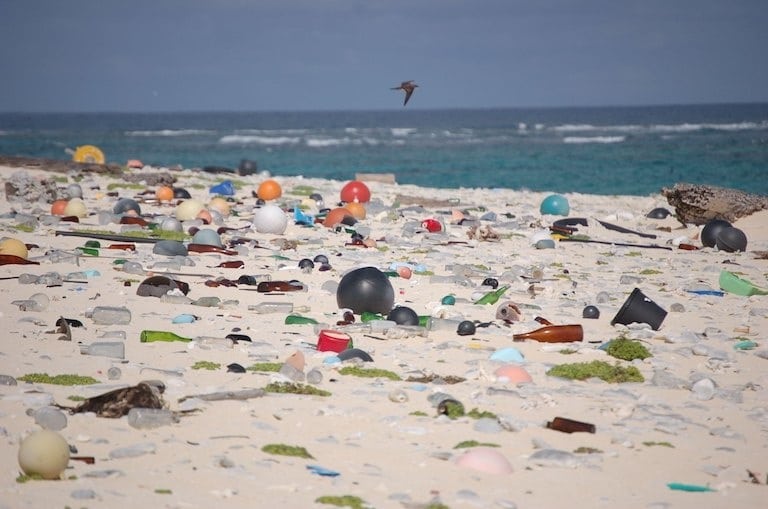
Marine debris litters a beach on Laysan Island in the Hawaiian Islands National Wildlife Refuge, where it washed ashore. Susan White / USFWS
While recycled plastic may seem like a satisfactory alternative to virgin plastic, a new study, published in July 2020, showed that children’s toys made out of recycled plastic contained high levels of toxic chemicals, comparable to levels found in hazardous waste.
Moore, who has been studying plastic pollution since his discovery of the floating debris in the North Pacific Ocean, says he doesn’t believe there’s an easy fix to this issue, especially when it comes to the businesses that are producing large amounts of plastic.
“There’s no change that corporations can make under the current system that will successfully combat plastic pollution,” Moore said. “There is no technical fix to the plastic problem. It’s not in the corporate portfolio to reduce sales of your products — the corporate portfolio is about increasing sales. The idea that [corporations] can be convinced to reduce their production and sale of the products that they make is a fantasy.”
However, Moore says a solution could be found in “radical change,” and that this moment of time, with the Black Lives Matter movement spreading across the world, could provide the opportunity for that change.
“Now is the time when a world historical revolution would be possible, when the people of the world could unite to change the system as a whole,” Moore said.
“There won’t be a techno fix and science won’t develop … a new product that will get us out of the problem of plastic pollution,” he said. “It will only come with the world as a whole agreeing to charter a new course towards a non-polluting future.”
Reposted with permission from Mongabay.
- Microplastics Are Wafting in on the Sea Breeze - EcoWatch
- People Eat 50,000+ Microplastics Every Year, New Study Finds ...
- Microplastics in Oceans Outnumber Stars in Our Galaxy by 500 Times
- Seafood Study Finds Plastic in 100% of Samples - EcoWatch
- Microplastics Found in Human Organs for First Time - EcoWatch
- Paint: The Big Source of Ocean Microplastics You Didn’t Know About - EcoWatch
- New Research Reveals How Airborne Microplastics Travel the World
- How to Reduce Ingesting Microplastics at Home

 233k
233k  41k
41k  Subscribe
Subscribe 